“The Heart of Mesopotamia: The Silent Story of the Mardin Museum”🏺🏛️“Mezopotamya’nın Kalbi: Mardin Müzesi’nin Sessiz Hikayesi”




Hello everyone. After our tour of the streets of Mardin, today I'd like to show you the Mardin Museum. Walking along Mardin's stone streets, it's impossible not to hear the voice of history. The sun casts a magical light on the yellow limestone that you won't find anywhere else. Rising among these stones, like a hidden treasure in the heart of the city, stands the Mardin Museum.
Herkese merhaba dostlar. Mardin sokaklarında ki gezimizin ardından bugün size Mardin Müzesini göstermek istiyorum. Mardin'in taş sokaklarında yürürken insan ister istemez tarihin sesini duyuyor. Güneş sarı kalker taşların üzerinde hiçbir yerde olmadığı kadar büyülü bir ışık bırakıyor. İşte o taşların arasında kentin kalbinde saklanmış bir hazine gibi yükselen Mardin Müzesi.















The museum building is inspired by the traditional 'Mardin house' architecture and integrates with its surroundings. In fact, all the structures here were built using the same technique to maintain the overall texture. The building is three stories tall, but don't mistake it for a completely flat, three-story building due to the rugged terrain. The upper floor, constructed using terraced structures, is smaller and narrower. Each floor features small rooms, and you should be careful not to bump your head as you enter these rooms, filled with artifacts. It resembles a cave. The rooms are arranged in an L-shape, with a central balcony resembling a balcony. This type of structure is quite common here. Now, let's explore the interior.🚶🏻
Müzenin yapısı geleneksel 'Mardin evi' mimarisinden esinlenmiş. Böylece bölgeye uyum sağlanmış diyebiliriz. Aslında burdaki tüm binalar aynı teknikle yapılmış doku bozulmak istenmemiş. Bina 3 kat şeklinde yapılmış ancak arazinin engebeli yapısından dolayı tam olarak düz 3 katlı bir bina aklınıza gelmesin. Teraslama yöntemiyle yapılmış yukarı kat daha küçük ve dar. Katlarda odacıklar var ve içleri eserlerle dolu odalara girerken kafanızı vurmamaya dikkat etmelisiniz. Mağara mantığıyla yapılmış gibiydi. Odacıklar L biçiminde konumlandırılmış ve orta kısım balkon gibi l, teras gibi üstü açık duruyordu. Buralarda böyle yapılar görmek çok normal. Şimdi birazda iç kısmı gezelim.🚶🏻










As we stepped through the museum's doors, we felt as if we'd traveled back in time. This building, formerly the Syriac Catholic Patriarchate, now embraces thousands of years of historical memory. Traces of countless civilizations, from Roman to Byzantine, Artuqid to Ottoman, are displayed here. Gold coins winked in one corner, while rising earthenware pots gazed silently at us in the other. The thought that this pot, perhaps centuries ago, had held the simmering soup of a mother's hearth was etched in our minds. 🍵
Müzenin kapısından içeri adım attığımızda sanki zamana dokunuyorduk. Eski bir Süryani Katolik patrikhanesi olan bu Yapı şimdi tarihin binlerce yıllık hatırasını kucaklıyordu. Roma'dan Bizans'a, Artuklular'dan Osmanlı'ya kadar pek çok medeniyetin izleri burada sergileniyor. Bir köşede altın paralar göz kırparken diğer tarafta toprağın altından çıkmış sade bir çömlek sessizliği ile bize bakıyordu.⚱️ İşte o çömlek belki de yüz yıllar önce bir annenin ocağında kaynayan çorbayı taşıyordu düşüncesini aklınıza takılıyor. 🍵
+++














The most beautiful aspect of the Mardin Museum was not only seeing the artifacts but also hearing their whispers. Each display case told us a story. Stone carvings declared, "We worked to beautify this city," while ancient seals cried, "We were once the guarantor of trust and promise." Every artifact in the museum's display case was like a voice rising from the depths of the earth. Roman gold coins once controlled the pulse of commerce. Byzantine seals symbolized trust. As we approached another display case, we encountered glittering silver and gold ornaments and trinkets, adorned with stones. Who knows, perhaps these rings had become a lifelong memory on a bride's finger.💍 Perhaps the necklaces were worn to ward off the evil eye? 🧿Even these tiny beads could convey a mother's love for her child, a lover's longing.🌟 These jewels weren't just ornaments; they seemed to carry the reflection of an emotion, a belief, a story.Gazing at the jewels under the dim lights of the museum, one senses that beauty lies not only in the stone itself but also in the lives of the people who wear it. Each object stared us in the eye as if it were no ordinary object but a relic of an era.
Mardin Müzesi'nin en güzel yanı sadece eserleri görmek değil onların fısıltılarını da duymak gibiydi. Her bir vitrin bir hikaye anlatıyordu bize. Taş işlemeler "biz bu şehri güzelleştirmek için çalıştık" derken, eski mühürler "bir zamanlar güvenin ve sözün garantisiydik" diye sesleniyordu bize. Müzenin vitrinlerinde duran her eser toprağın derinliklerinden yükselen bir ses gibiydi adeta. Roma dönemine ait altın sikkeler bir zamanlar ticaretinin nabzını tutmuş.🪙 Bizans'tan kalma mühürler ise güvenin sembolü olmuş.💳Başka bir vitrine yaklaştığımızda parlayan gümüşler, altın işlemeler ve taşlarla süslü incik boncuklar karşıladı bizi. Kim bilir belki de bu yüzükler bir gelinin parmağında bir ömürlük hatıra olmuştur. Kolyeler sahibini nazardan korusun diye takılmıştır belki de... Bu küçücük boncuklar bile bir annenin çocuğuna sevgisini, bir sevgilinin özlemini taşımış olabilir. Bu takılar yalnızca süs eşyası değil bir duygunun, bir inancın, bir hikayenin yansımasını taşıyor gibiydi. Müzenin loş ışıkları altında mücevherlere bakarken güzellik sadece taşta değil onu takan insanların hayatında saklıymış diye geçiriyor insan içinden. Her obje ben sadece bir eşya değilim bir dönemin hatırasıyım derecesine gözlerimize bakıyordu.












Let’s talk about the sarcophagi a little.🪦 When you step into one of the halls of the Mardin Museum, time suddenly slows down; because the sarcophagi you see are not just stones, they are like silent witnesses of thousands of years. The magnificent burial cists of this geography that has hosted many civilizations seem to still whisper the stories of their owners. 🪦⚰️The figures engraved on the stones reflect the beliefs of the period and hopes for the afterlife. Standing in front of the sarcophagi while thinking of this magnificent farewell made for a people who lived on the same lands hundreds of years ago left us with both awe and sadness.🪦⚰️ This silence echoing between the stone walls of the Mardin Museum was actually the most touching proof that the past is still alive... Does looking at these stone cists evoke the same feelings in you?
Biraz da lahitlerden bahsedelim.🪦 Mardin müzesi'nin salonlarından birine adım attığınızda zaman birden ağırlaşır; çünkü karşınıza çıkan lahitler sadece taş değil binlerce yılın sessiz tanıkları gibidir. Birçok uygarlığa ev sahipliği yapmış bu bölgenin görkemli mezar sandukaları sanki hala sahiplerinin hikayelerini fısıldar gibi. 🪦⚰️Taşların üzerine işlenmiş figürler dönemin inançlarını, ölümden sonraki hayata dair umutları yansıtır. Lahitlerin önünde durup yüzlerce yıl önce aynı topraklarda yaşamış bir insanın ardından yapılan bu görkemli uğurlamayı düşünmek bizlere hem hayranlık hem de hüzün bırakmıştı.🪦⚰️ Mardin Müzesi'nin taş duvarları arasında yankılanan bu sessizlik aslında geçmişin hâlâ yaşadığının en dokunaklı kanıtlarıydı bizim için... Bu taş sandukalara bakmaz sizde de aynı duyguları uyandırıyor mu*?




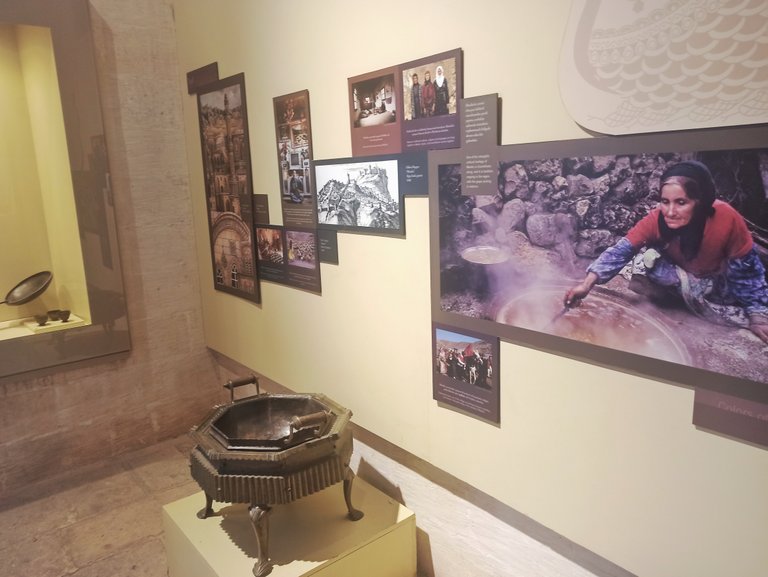













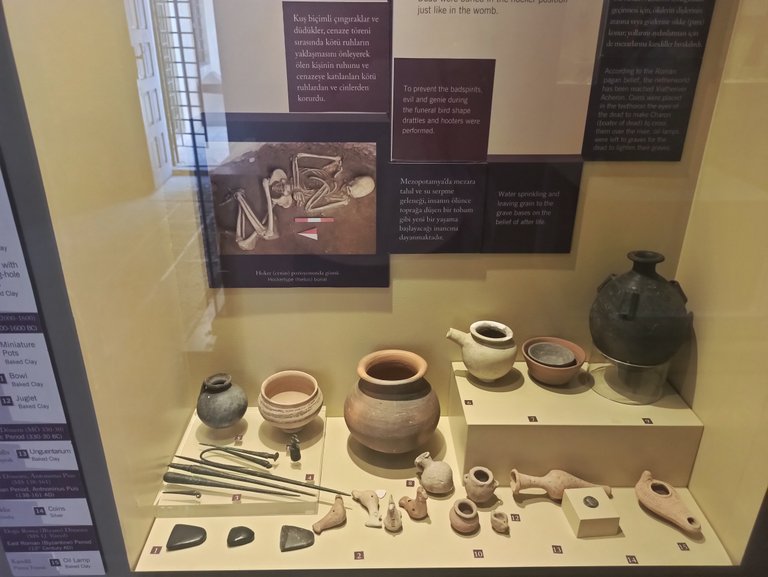








As we wandered through the narrow corridors of the museum, ordinary-looking earthenware pots, copper jugs, small scales, and ornate water jugs were displayed in the display cases. Each object tells the story of people who once lived. For example, people drinking water from jugs and shopkeepers weighing spices on small scales come to mind. 🌶️As you proceed a little further, you come across traditional kitchenware, weaving looms, and old hand tools. 👚🥻 Thanks to these objects, you feel as if you’re wandering through Mardin’s stone houses, spice-scented kitchens, in other words, the hustle and bustle of daily life. Small slices of social life establish an intimacy only history books can offer. As you proceed a little further, you encounter ritual objects that directly connect the daily lives of past people with social and spiritual ties. Small oil lamps, miniature holy books, amulets, and stones inlaid with prayers. All of them were once woven into people’s daily lives through their beliefs, used to protect and guide them.Looking at these objects, one doesn't just see stone and metal; one also senses the lives of the people of those lands, woven together by faith, hope, and ritual. Every talisman, every amulet whispers a story; perhaps a reminder of a birth, a reckoning, or a step taken to ensure the well-being of a home. And what's fascinating is how each object still manages to quietly influence visitors.
Müzenin dar koridorlarında dolaşırken vitrinlerin içinde sıradan gibi görünen toprak kaplar bakır tencereleri küçük tartılar ve süslenmiş su testleri vardı.🏺 Her bir obje bir zamanlar yaşayan insanların hikayesini anlatıyor. Mesela testilerden su içmiş insanlar, küçük terazilerde baharat tartmış esnaflar aklınıza geliyor. 🌶️Biraz ilerleyince geleneksel mutfak gereçleri dokuma tezgahları ve eski el aletleri gözümüze çarpıyor.👚🥻 Bu eşyalar sayesinde Mardin'in taş evlerinde, baharat kokulu mutfaklarında yani günlük hayatın telaşında dolaşıyor gibisiniz. Sosyal yaşamın küçük parçaları tarih kitaplarının vereceğiniz bir samimiyet kuruyor bizlerle. Biraz daha ilerleyince gördüğümüz ritüel objeleri geçmişin insanlarının günlük yaşamını doğrudan sosyal ve manevi bağlarla birleştiriyor. Küçük kandillerminyatür kutsal kitaplar, nazarlıklar ve dualarla işlenmiş taşlar gibi. Hepsi bir zamanlar insanların inançlarında günlük hayatlarına dokunmuş onları korumak ve yönlendirmek için kullanılmış. Bu objelere bakarken insan sadece taş ve metal görmüyor; o toprağın insanlarının inançla, umutla ve ritüellerle örülmüş yaşamını hissediyor. Her tılsım her nazarlık bir hikaye fısıldıyorum belki bir doğumda belki bir hesap döneminde belki de bir evin bereketi için yapılmış bir adımı hatırlatıyor... Ve yine işin büyüleyici yanı her objenin hala sessiz bir şekilde ziyaretçilere dokunabilmesi.


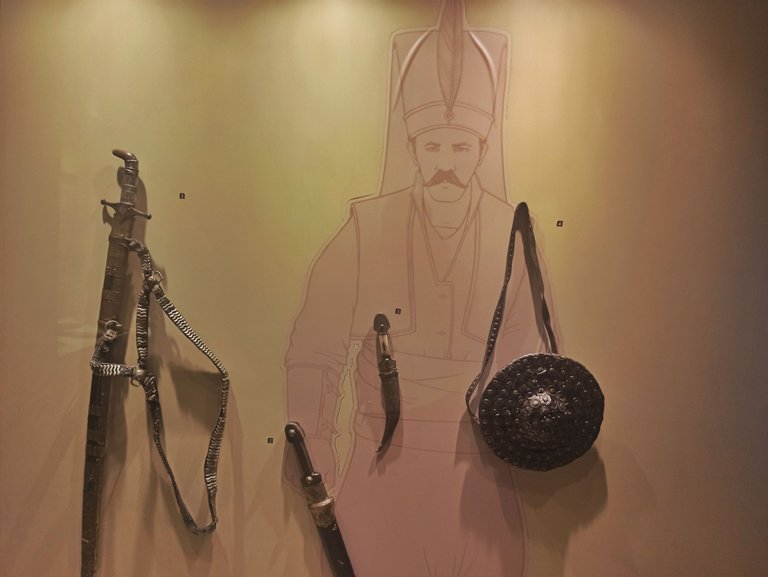

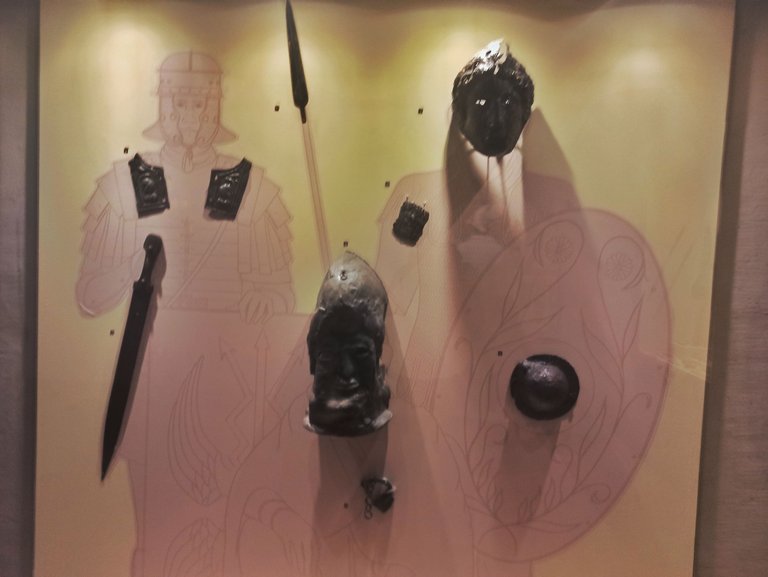



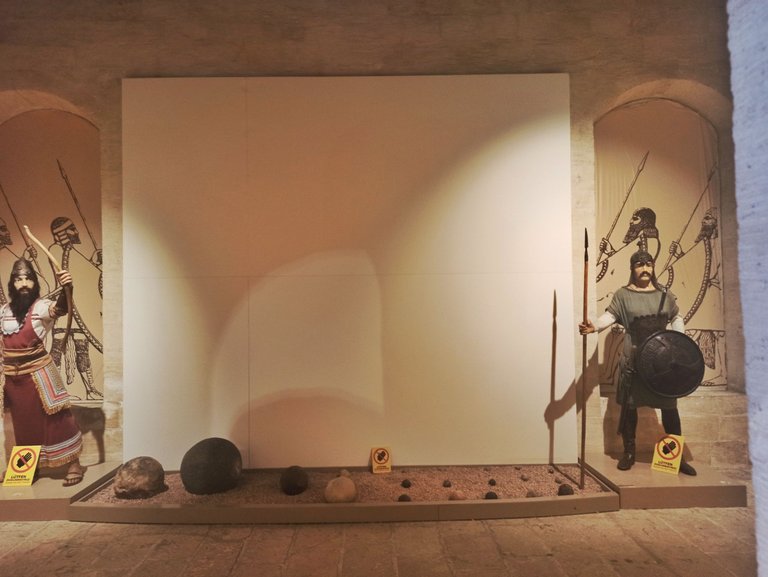


I'd like to chat with you a little about the weapons and implements of war. The implements of war we encountered in a corner of the museum reflected both the might of humanity and the spirit of struggle that has endured throughout history. Bronze arrowheads, spears, swords, guns, and small pieces of armor carried the stories of people with sweaty hands living in the shadow of war. 🏹⚔️🗡️When you look at these objects, you see not only the metal, but also the courage and determination of those who wielded these weapons, those who tried to protect themselves, and those who defended their lands. I believe that museums don't just display weapons of war; they present them alongside stories of survival and resistance from the past. Bronze seals, small pieces of equipment used by soldiers, and pieces of armor demonstrate how war was intertwined with daily life at the time. As you pass by these objects, you feel the tense, intense, and snowy atmosphere. Each of these objects seems to say, "We were here; we protected, we fought, we lived."💬All these instruments of war reveal stories of resistance and preservation of the human spirit, seeming to unite the present with the power of the past. 🗡️⚔️🏹
Biraz da savaş aletleri ve silahlar üzerine sohbet etmek istiyorum sizlerle. Müzenin bir köşesinde karşılaştığımız savaş aletleri insanın hem kudretini hem de tarih boyunca süregelen mücadele ruhunu göstermişti bizlere. Bronz ok uçları mızraklar, kılıçlar, silahlar ve küçük zırh parçaları hepsi bir zamanlar elleri terlemiş, savaşın gölgesinde yaşamış insanların hikayesini taşıyordu.🏹⚔️🗡️Bu objelere bakarken sadece metal değil, bu silahları tutmuş, kendini korumaya çalışmış, toprağını savunmuş insanların cesaretini ve kararlılığını da görüyorsunuz. Bence müzeler savaş aletlerini yalnızca sergilemekle kalmaz onları geçmişin hayatta kalma ve direniş hikayeleri ile birlikte sunar. Bronz mühürler, askerlerin kullandığı küçük teçhizatlar veya zırh parçaları o dönemin günlük yaşamıyla savaşı nasıl iç içe geçirdiğini gösteriyordu bizlere. Bu objelerin önünden geçerken gergin, yoğun ve karlı atmosferi hissediyorsunuz.💬 Bu eşyaların her biri sanki biz buradaydık, koruduk savaştık yaşadık der gibiydi. Tüm bu savaş aletleri insan ruhunun direniş ve korunma hikayelerini gözler önüne seriyor geçmişin kudretiyle bugünü birleştiriyor gibiydi. 🗡️⚔️🏹



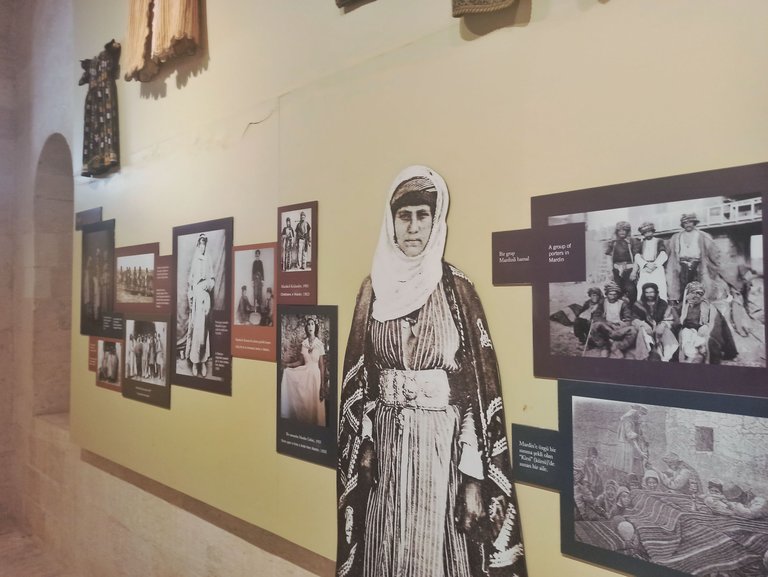

*Finally, I'll conclude by touching on old textiles and agricultural products. The old loom pieces, the thickness of the woolen threads, and the natural hues of the colors looked as if they were handcrafted by women working in the cool morning breezes of Mardin's hillside villages; and they probably were. 🙂🥻👚 The patterns embroidered on the fabrics exuded an elegance intertwined with the colors of nature. Some motifs depicted abundance, others a protective faith, and still others love. When you look at these woven works, you sense the lives hidden within the threads, patiently crafted stitch by stitch.🧶🧵
Son olarak eski dokuma parçalar ve tarım ürünlerine değineceğim ve yazımı bitireceğim. Eski dokuma tezgahlarının parçaları, yün ipliklerinin kalınlığı, renklerin doğal tonu hepsi Mardin'in yamaç köylerinde sabahın serinliğinde çalışan kadınların ellerinden çıkmış gibiydi, ki muhtemelen öyle de olmuştur.🙂🥻👚 Kumaşları işlenen desenlerde doğanın renkleri ile iç içe geçmiş bir zarafet vardı. Kimi motif bereketi, kimi koruyucu inancı, kimi de sevda'ya anlatıyordu adeta. Bu dokuma eserlere bakarken bir yandan ipliklerin arasına gizlenmiş hayatları hissediyorsun, ilmek ilmek sabırla işlenmiş.🧶🧵




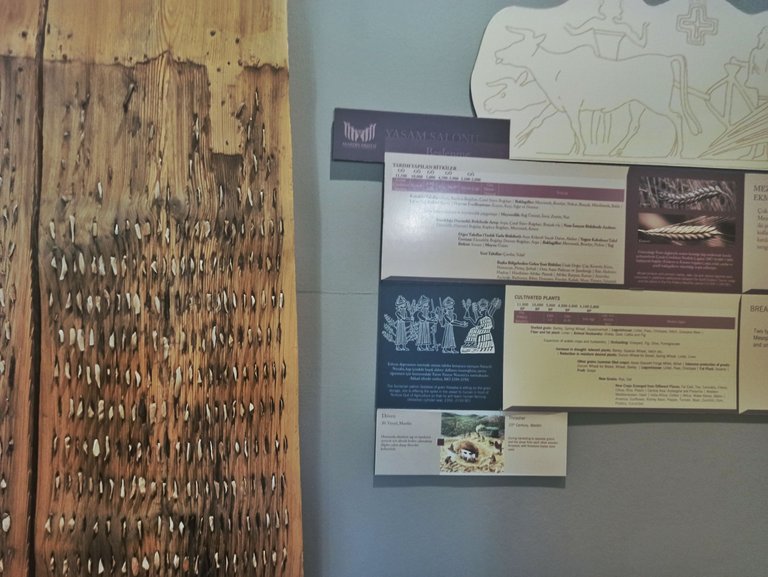



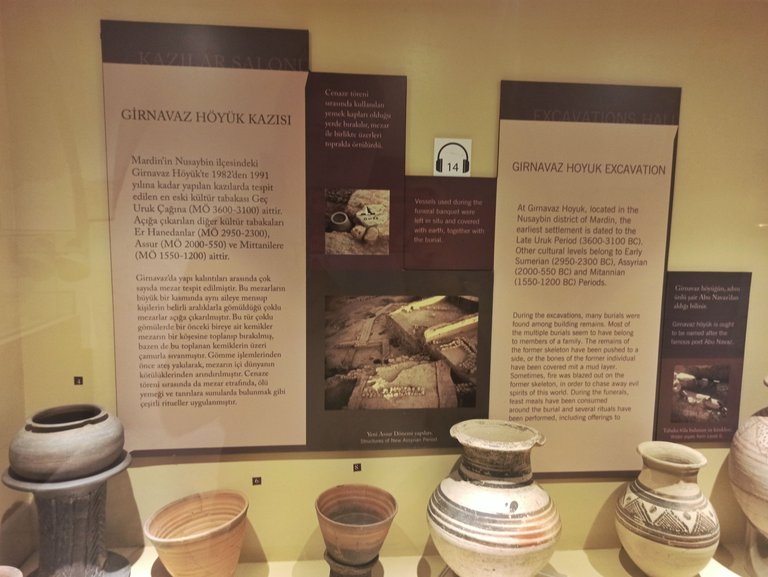
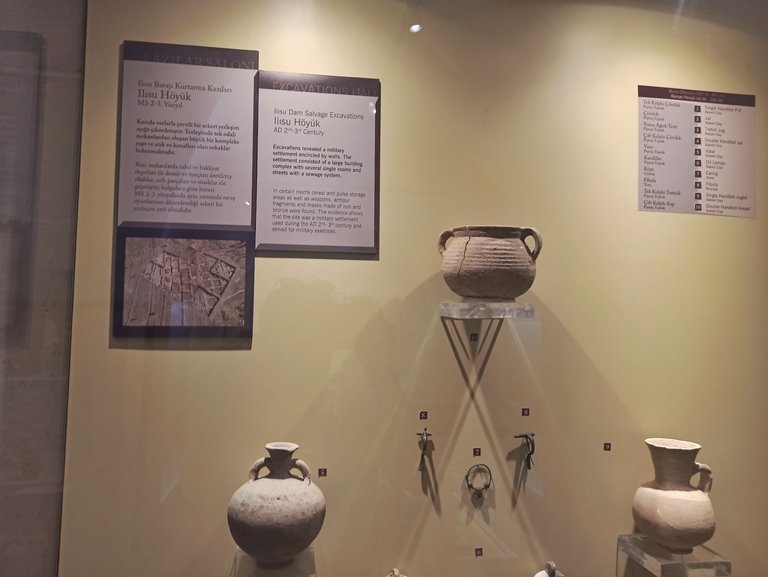

A little further on, we were greeted by agricultural implements lined up along the wall: rusty plowstones and wooden tools. They whispered a story from a bygone era: the fertility of this land lies in adapting to its rhythm. It was a story of labor that began early in the morning and continued until sunset. We were reminded of how generous the land has always been to us.🌾🚜
Biraz ileride duvarın dibinde dizilmiş tarım aletleri karşılıyordu bizi pas tutmuş saban taşları, ahşap düvenler. Bir dönemin geçmiş hikayesini fısıldıyor bu topraklarda yaşamam bereketi toprağın ritmine uymakla mümkün sabahın erken saatlerinde başlayan gün batımında bile bitmeyen bir emeğin hikayesi. Toprağın her zaman bizler için ne kadar cömert olduğunu hatırladık. 🌾🚜


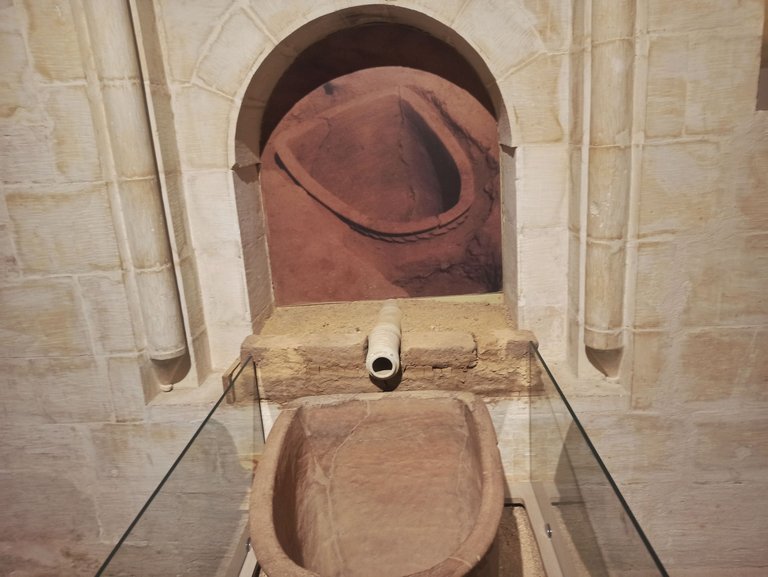



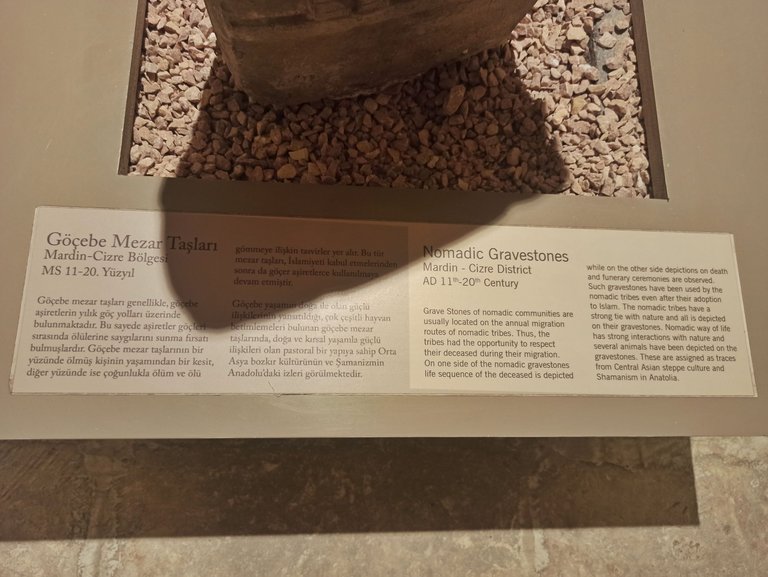
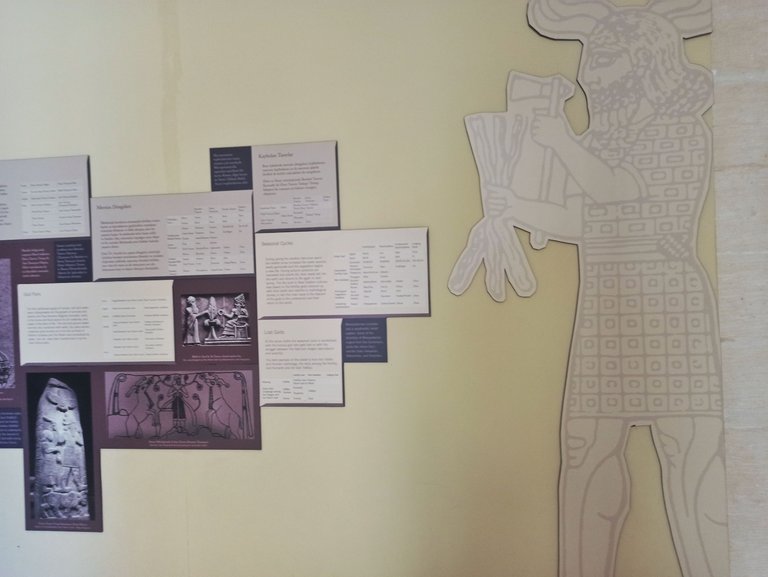





I took photos of some of the works along with the descriptions. If you're curious, you can zoom in and read them. Most of them have information in both languages. Thank you so much for reading this meticulously written travelogue. See you soon. 🌟
Bazı eserleri yanlarındaki açıklamalarıyla birlikte çektim merak ediyorsanız yakınlaştırıp okuyabilirsiniz. Çoğunda her iki dilde de bilgiler mevcut. Emekle yazdığım bu gezi yazımı sonuna kadar okuduysanız çok teşekkür ederim. Görüşmek üzere.🌟



You can check out this post and your own profile on the map. Be part of the Worldmappin Community and join our Discord Channel to get in touch with other travelers, ask questions or just be updated on our latest features.
Such a beautiful and detailed post! It really feels like stepping back in time. 🏺✨
I'm so glad you liked it. I tried to write in detail. Thank you so much for your support.🌺🌟✨
You received an upvote ecency
Hiya, @ybanezkim26 here, just swinging by to let you know that this post made it into our Top 3 in Travel Digest #2703.
Your post has been manually curated by the @worldmappin team. If you like what we're doing, please drop by to check out all the rest of today's great posts and consider supporting other authors like yourself and us so we can keep the project going!
Become part of our travel community:
Hazır Şanlıurfa'dayken Mardin gezisi yapmayı düşünüyorduk onun üzerine bunu görmemiz çok iyi oldu. Mimarisiyle tarihiyle önemli bir yer Mardin ve siz de çok güzel zaman geçirmişsiniz. Umarım bu gönderilerin devamı gelir :)
Mardin'i kesin görmeniz gerek açıkçası bende Urfa'yı çok merak ediyorum.🙂 Çok teşekkür ederim 🌺